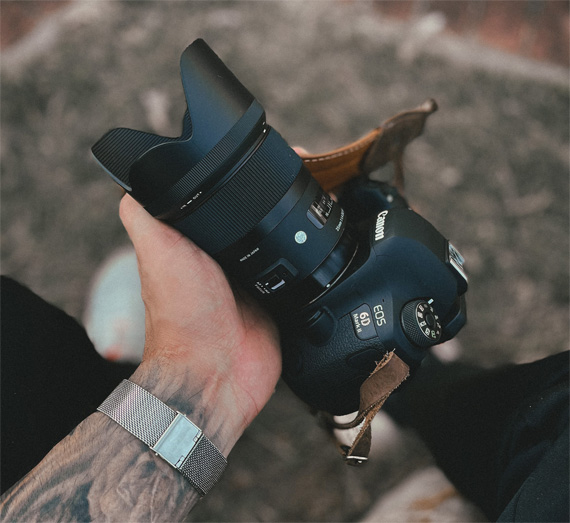It is very important to maintain your digital SLR camera, which involves cleaning the camera and its related components. This article will assist you and provide some information on how to carefully clean the most important items. The cleaning process may sound simple, but you really have to be careful. A clean camera is a happy camera. You’ll take better photos with a clean camera, so plan to clean it regularly.

Photo by Allef Vinicius
The Lens
There are generally three parts you need to clean in a lens: the front of the lens, the back of the lens, and the filter (if you have one).
- Place your lens on a stable platform (e.g. a table) in an isolated area—preferably the bathroom or somewhere that has very little dust.
- Use a blower on the front side of the lens to blow some of the larger dust particles away.
- Drop about 5-6 drops of lens solution onto the front side of the lens.
- Using a micro-fiber cloth, gently wipe the lens in a spiral movement starting from the center.
- Using the same micro-fiber cloth, repeat the spiral motion from the center a couple of times.
- Use the blower to give a final blow on the lens.
- Repeat steps 2-6 to clean the filter.
- For the back side of the lens, use a blower to blow the dust away and use a soft brush to brush the dust away. I do not recommend you use lens solution on the back side of the lens, as it may damage the lens.
The Sensor
Before reading through this, here is a disclaimer:
I am not and will not be responsible for any damage occur to your camera. All camera damages are under the responsibility of the owner. The following information provided will assist you in cleaning the sensor of the camera. All physical activities done upon the camera are of the owner’s choice and judgment.
I write this disclaimer because the sensor is the most expensive, delicate, fragile, and important component in your camera. Therefore YOU have to take care of it properly. The bad news is that your sensor will eventually become dirty and you will eventually have to clean it. The choice is yours.
To check whether or not your sensor is dirty you ca,n run a simple test. Set your camera into aperture-priority mode and select the maximum F-number (smallest aperture). Set your focusing to manual and focus to infinity. Point toward a bright and plain source, and take the photo. Preview the photo to detect any apparent black spots. The spots are dust in your sensor. To clean the sensor follow these steps:
- Lock your mirror up. Refer to your owner’s manual for this feature.
- Place the camera on a stable platform in an isolated area—preferably the bathroom or somewhere that has very little dust.
- Remove the lens from the camera body.
- Use a blower initially to blow the larger dust particles away.
- Use a sensor cleaner to gently wipe the sensor.
- Wipe the sensor either in a linear pattern, a star pattern, or a spiral pattern starting from the center. (The aim is to remove all the dust by wiping away from the center).
- Attach the lens back onto the body and check if all the dust is gone.
- If not, repeat steps 1 to 6.
Cleaning Camera Do Nots
- Do not use the same brush for the lens and the reflex-mirror.
- Do not use a lens cleaner to clean the sensor.
- Do not use any cleaner to clean your sensor unless it says “sensor cleaner.”
- Do not press on your sensor too hard while cleaning. (Be patient!)
- Do not use too much lens solution for your lenses. (All lenses are coated with a fine digital film to protect the lens. You might “clean” this away!)
- Do not use a vacuum cleaner for your sensor. (Although I’ve seen people do it, the risk is just too high!)
About the Author:
Joe Chin from ExtremePhotographix is a passionate photographer who constantly gives advices to those who just begun their journey in photography. Click the following link to get all the comprehensive information of Joe’s tips and strategies which may help you to capture fantastic and breath-taking photographs.
Like This Article?
Don't Miss The Next One!
Join over 100,000 photographers of all experience levels who receive our free photography tips and articles to stay current:






Nice concise article. I messed up the coating of a filter using lens fluid. Maybe I used too much? I think it’s better to avoid using lens fluid on some kinds of filters, e.g. fluorescent filters.
Hi,
Thanks for your picturecorrect stories. I think they are a great help for beginners and sometimes for advanced photographers, too. In this article you missed the easiest way to clean a sensor. For years i did it like you mentioned, with swabs pec- pads and fluid but two years ago, I found those plastc sticks with a silicone tip. Well silicone is very sticky – you just take a magnifing glas in one hand, the stick in the other, you need a well positioned light, too, i use an LED Officetablelight. Now you see this micro dirt parts on the sensor just tip it away with the silicon part – everything will ‘glue’ to the silicone. When you are finished just wash the tip in water – all dirt is gone and when the tip is dried its sticky again. Very fast, very effective a lot easier than the swab way… Best greetings from Switzerland Tom
Great tips there. Glad you mentioned vacuum cleaners in your “don’t” section. I’ve seen a few people do it and it’s not a good idea!